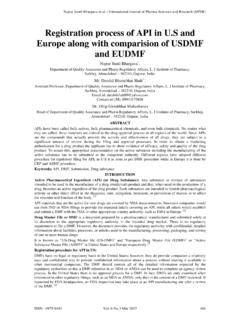Transcription of An Ayurvedic Review on management of Tamaka …
1 An Ayurvedic Review on management of Tamaka Shwasa Kimmi Seth*, Nitesh Anand** *BAMS (Ayu.), Asst. Prof in Kayachikitsa, Motherhood Ayurved Medical College, Roorkee **MD Scholar PG dept. of Panchkarma, Rishikul Campus Haridwar Contact No.: 08449609809, 09045647531 Abstract - Respiration is the evident feature of life which is carried out by Prana vayu. This sole sign of life is affected in this disease Tamaka Shwasa, causing an impediment to the Respiratory function. Shwasa word indicates both physiological and pathological state of respiration.
2 Ayurvedic texts have mentioned Tamaka Shwasa under the various types of Shwasa roga. Disease Tamaka Shwasa can be correlated with the disease Bronchial Asthma on the basis of its features & etiopathogenesis. Tamaka Shwasa is considered as Yapya (palliable) because this type of Shwasa roga is not only difficult to treat but also has a repetitive nature. Bronchial Asthma calls the attention of Medical world due to significant burden in terms of healthcare costs as well as lost productivity and reduced participation in family life.
3 The Science of Life Ayurveda is the best way to effectively & safely manage the condition without inducing any drug dependency where various Shodhana procedures and use of internal medication not only detoxifies the body but also provides nutrition & increases the elasticity of lung tissue & develops natural immunity of the body thus decreasing episodic recurrence of the disease and providing long term relief to the patient. Keywords: Tamaka Shwasa, Bronchial Asthma, Ayurveda INTRODUCTION Tamaka Shwasa is one of the five types of disease Shwasa.
4 The signs, symptoms and etiopathogenesis of Bronchial Asthma explained in modern science have a lot of similarities with the disease entity Tamaka Shwasa. The main features of Bronchial Asthma are breathlessness, chest tightness, wheezing and cough. Bronchial Asthma is a major global health problem, which can affect the population irrespective of age, sex, economic status, etc. It is very common at all ages but predominantly in early life. The prevalence of Bronchial Asthma is increasing alarmingly now a days due to excessive pollution, overcrowding, occupational conditions, stress and poor hygiene etc.
5 Both Ayurveda and modern medical Science agree regarding the Nidana of the disease as host factors (Nija Hetus-Dosha dushti and Ama) and Environmental factors (Agantuj Hetus Raja, Dhuma, Pragvata, etc). It can be easily correlated with allergic condition. Nidana Parivarjan hence plays a key role in the management strategy in both sciences. The current management of Tamaka Shwasa (Bronchial Asthma) by modern medicine is only providing short term symptomatic relief but does not provide any long term relief to the patient.
6 On the other hand prolonged use of these drugs are not safe, as it has many adverse effect with systemic manifestation and as the chronicity increases drug dose dependency increases & dialates the lung tissue to such an extent that at last it leads to respiratory failure. In present scenario Ayurveda is the best way to effectively & safely manage the condition without inducing any drug dependency where use of various shodhana procedures and use of internal medication not only detoxifies the body but also provides nutrition & increases the elasticity of lung tissue & develops natural immunity of the body.
7 Thus decreasing episodic recurrence of the disease and providing long term relief to the patient. Ayurvedic ASPECT OF Tamaka SHWASA Tamaka Shwasa comprises of two words Tamaka and Shwasa. The word Tamaka is derived from the Dhatu "Tamglanou" which means Sadness (Panini). According to Vachaspatyam the word Shwasa is derived from the root word 'Shwas' Dhatu by applying Ghanj Pratyaya. It implies for both Vayu Vyapara & Roga Bheda. It represents both physiological as well as pathological respiration and used for expression of word.
8 The disease is called Tamaka as attack of the disease precipitate during night and during the state of attack dyspnoea becomes so severe that patient feels entering into the darkness. Main causative factors responsible for Tamaka Shwasa are Dhuma (smoke), Raja (dust), Ativyayama (excessive exercise/work), Sheeta sthananivasa (residing in cold areas), Guru bhojana (heavy diet) and Sheeta bhojana (cold food/drinks). These factors lead to the vitiation of Vata which in turn vitiates Kapha leading to vitiation of Rasa and impeding the function of Pranavata.
9 According to our Ayurvedic literature vata is captured by the Aavrana of kapha in this disease. Acharya Charaka has mentioned that Tamaka Shwasa is kapha-vataja vikar and site of its origin is pitta sthana . In Sushruta Samhita, Madhava Nidana and Yogratnakar it is mentioned that Tamaka Shwasa is Kapha predominant disorder. When going through the lakshnas of Tamaka Shwasa in our Ayurvedic literature our Kimmi Seth et al. / International Journal of Pharma Sciences and Research (IJPSR)ISSN : 0975-9492 Vol.
10 7 No. 6 Jun 2016274 Acharayas has told Gurghurkam(audible wheezing), Pinasa(coryza), Shirogaurava (heaviness in head region), kricchat bhashitum (difficulty in speaking) etc. all the Lakshnas showing Kapha predominancy. Tamaka Shwasa in general is described as yapya (palliable) disease. However in individual with recent origin of disease, person of pravarabala or both said to be sadhya. Maharshi Charaka has mentioned two-allied stages of Tamaka Shwasa known as two types or further complication of disease proper Pratamaka and Santamaka.










